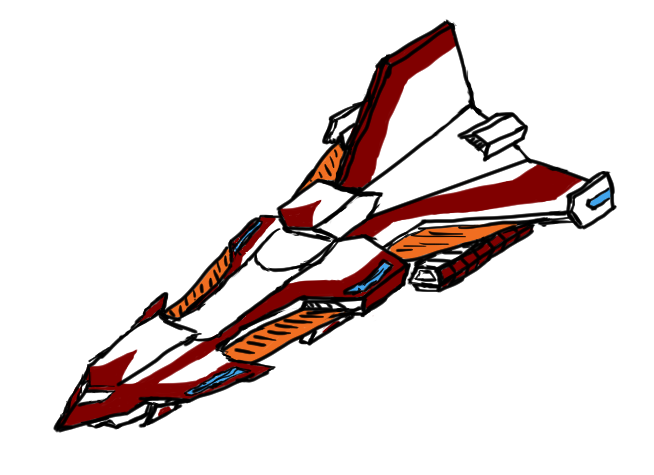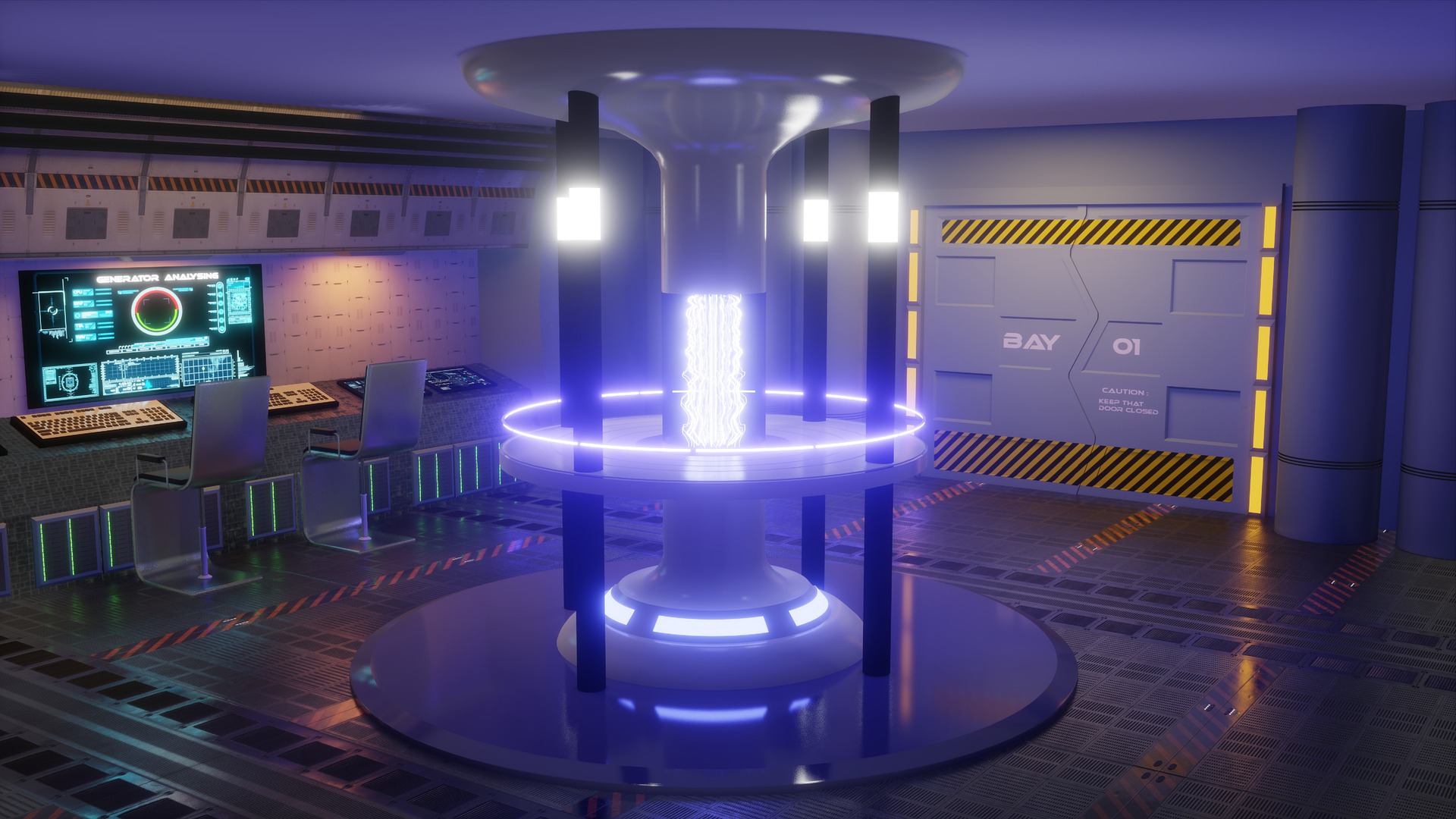ESRV Challenger
The ESRV Challenger is a Whistance-class planetary and xenological research ship of the Exploration Service, part of the science arm of the Stellar Compact. Under the command of Section Captain Arthur Benson, a noted maverick, the Challenger has been notable for its role in such events as the rediscovery of Meridian and first contact with the Uzen.
Design
Described as resembling an elongated arrowhead with a tailfin, and gravity brakes and radiators along its sides, the Challenger was built by Central Dynamics under a procurement contract for the Exploration Service, one of a new fleet of science vessels for the latter half of the second Unified Century. The ship is approximately 400 meters long, large enough to contain a shuttle hangar, ground vehicle bay, comfortable crew furnishings, and a full suite of science labs. Since it is designed to land on planets, the Challenger departs from the usual vertical arrangement of ship decks in a skyscraper-esque pattern and instead uses a horizontal layout. This puts its exit hatches and cargo ramp closer to the ground, and facilitates a floorplan which does not require frequently changing between decks to access different rooms, but requires a simgrav system to counteract acceleration from the engines at the stern.Propulsion
Interplanetary propulsion is provided by an array of three fusion matrix engines built from scavenged Enclaver technology, consisting of one large unit at the rear of the main hull, and two smaller outboard engines mounted in the wing pylons. Using a catalyzed deuterium-deuterium fuel cycle, these engines have a specific impulse of over one million seconds and a maximum emergency thrust of around five standard gravities. Normal cruise thrust is 0.25g, for efficiency, and in this mode total delta-v capacity is approximately 2,000 kilometers per second, enabling the Challenger to survey multiple points of interest across a solar system in a matter of a few months. Refueling can be accomplished by scooping deuterium from gas giant atmospheres.
Orbital maneuvering, takeoffs, and landings are accomplished with fusion-thermal engines using water as reaction mass, which though far less efficient than the main torches, do not expel radioactive exhaust and hence are suitable for use in atmospheres and low orbits. These engines are also used in refueling, expelling waste gases after deuterium is filtered out, to counteract drag and re-boost the ship's orbit. Six gravity brakes give static lift, enabling the Challenger to hover in a planet's gravity indefinitely with little energy expenditure.
Heat rejection is provided by four arrays of radiator panels mounted on the ship's sides, augmentable with an additional liquid droplet system which can be run out like a pair of large sails.
Interstellar travel is accomplished by passing through stargates; the Challenger can fit handily through 250-meter standard frontier gates. Its lower hangar bay also has enough space to carry a portable wormhole projector, though it will require the services of another ship such as an exploration carrier or wormhole tender to transport the components necessary to build a stargate.
Orbital maneuvering, takeoffs, and landings are accomplished with fusion-thermal engines using water as reaction mass, which though far less efficient than the main torches, do not expel radioactive exhaust and hence are suitable for use in atmospheres and low orbits. These engines are also used in refueling, expelling waste gases after deuterium is filtered out, to counteract drag and re-boost the ship's orbit. Six gravity brakes give static lift, enabling the Challenger to hover in a planet's gravity indefinitely with little energy expenditure.
Heat rejection is provided by four arrays of radiator panels mounted on the ship's sides, augmentable with an additional liquid droplet system which can be run out like a pair of large sails.
Interstellar travel is accomplished by passing through stargates; the Challenger can fit handily through 250-meter standard frontier gates. Its lower hangar bay also has enough space to carry a portable wormhole projector, though it will require the services of another ship such as an exploration carrier or wormhole tender to transport the components necessary to build a stargate.
Weapons & Armament
While not a military ship, the Challenger still possesses high-grade weapons in case it should encounter pirates, feral replicators, hostile aliens, or other such threats in the Starweb's frontiers. Its primary armament are two beam projectors, capable of hurling an ultrarelativistic stream of electrons at a target with enough power to melt through meters of armor. Secondary armament consists of torch torpedoes and lasers.
In combat mode, the Challenger uses its droplet-radiator system to provide additional heat rejection and increase its endurance. Consisting of molten metal droplets sprayed from a nozzle to a collection trough, this system is also resilient to damage since it contains few solid components for weapons fire to strike.
In combat mode, the Challenger uses its droplet-radiator system to provide additional heat rejection and increase its endurance. Consisting of molten metal droplets sprayed from a nozzle to a collection trough, this system is also resilient to damage since it contains few solid components for weapons fire to strike.
Armor and defense
Its first line of defense is its kinetic deflectors, tuned to detect incoming fire and impart a force on it to deflect it aside. This only works on material projectiles like missiles and torpedoes, or e-beams at long ranges, lasers pass right through and are instead dealt with by a layer of superconducting armor plating. The deflectors are also augmented by lasers for point-defense.
But perhaps its most impressive defense, and most impressive weapon as well, is its torch laser. This system redirects the ship's terawatts of engine power into a high-energy weapon by constricting the exhaust and throwing in a lasing medium, creating a flash of x-rays concentrated into a beam. While devastating at close ranges, this beam is not as highly collimated as a dedicated laser and is thus unsuited for striking distant targets even given its immense power. To an outside observer, a firing of the torch laser will look like the fusion engine plume tightening up and flashing from a brilliant white to a deep purple.
But perhaps its most impressive defense, and most impressive weapon as well, is its torch laser. This system redirects the ship's terawatts of engine power into a high-energy weapon by constricting the exhaust and throwing in a lasing medium, creating a flash of x-rays concentrated into a beam. While devastating at close ranges, this beam is not as highly collimated as a dedicated laser and is thus unsuited for striking distant targets even given its immense power. To an outside observer, a firing of the torch laser will look like the fusion engine plume tightening up and flashing from a brilliant white to a deep purple.
Sensors
As a research ship, the Challenger is equipped with an impressive array of sensors and observation equipment, such as telescopes, ground scanners, and signal decoders. Assisted by its probes and survey satellites, it can map the entire surface of a planet from orbit in short order.
Hangars & docked vessels
The Challenger has two main hangars, an upper bay for launching and retrieving space shuttles, and a lower bay with a ramp for ground vehicles, connected to internal cargo space via large elevators. Both are equipped with deflector projectors around their exits to retain pressure even when the exterior hatches are open to vacuum, though regulations still require crewmembers inside to wear space suits and tethers in case this system fails—it is intended more as a convenience to avoid the need to constantly pump large quantities of air into and out of the bays during flight operations.
ESRV Challenger

Whistance-class Ship by AntimatterNuke
Designation
Exploration Service Research Vessel
Manufacturer
Crew
Owning Organization
Length
~350 meters
Weight
~100,000 tons
Complement / Crew
~300
Cargo & Passenger Capacity
Several thousand tons, or several thousand passengers (in high-density berthing)
- 3x Enclaver Fusion Matrix, spin-polarized deuterium-deuterium cycle (interplanetary torch drive)
- Fusion-Thermal Engines (atmospheric and orbital maneuvering)
- 6x gravity brake (static lift)
- 2x ultrarelativistic electron beam projector, non-turreted
- Torpedoes
- Torch laser
- Kinetic deflectors
- Point-defense lasers
- Superconducting armor
- Refueling scoops
- Simgrav-equipped crew cabins
- Scientific sensor suite
- Observation shield (nonstandard)
- Wormhole projector (nonstandard)
- 3-5x Space shuttles
- Probes
- Survey satellites
- Ground vehicles




Really well thought-out article. Congrats on a job well done!